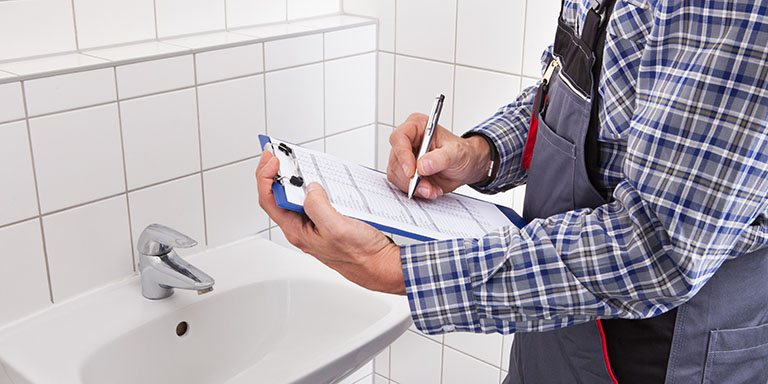When buying a home, it’s common for people to overlook the importance of plumbing. Unfortunately, many homeowners fail to evaluate the condition of the plumbing system and end up facing costly repairs or replacements later on. It’s important to note that various plumbing issues can be present in any home, some of which may not be immediately apparent without thorough testing and inspections. In our previous blog post, we discussed essential tips on how to avoid expensive surprises related to plumbing when purchasing a home in Winston-Salem. In this blog post, we will continue to provide crucial information to help you make an informed decision.
Water Heater
When examining the plumbing in a house, it’s important not to neglect the water heater. Repairing or replacing it can be quite costly. Here are some key points to consider when inspecting the water heater.
1. Water Heater Location
When purchasing a new home, it is crucial to determine the location of the water heater and assess whether its placement could potentially cause property damage. For instance, in the event of a leak, would it jeopardize hardwood or carpet flooring? Could it harm the drywall? If the answer to any of these is yes, it is advisable to contemplate preventive measures to mitigate potential damage.
Water heaters are typically installed in inconspicuous areas, yet they have the potential to cause considerable damage if they develop a leak. These areas include utility closets, water heater closets in mobile homes, and garages connected to finished living spaces. Although water heaters in these locations are often equipped with pans and drains, these safeguards can only contain a limited amount of water before overflowing. Unfortunately, homeowners often remain unaware of these leaks until they have already inflicted significant harm.
2. Water Heater Condition
Inspect the pipes leading to and from the tank for signs of corrosion or buildup. If you identify corrosion on the tank, it indicates the need for a replacement. Additionally, thoroughly examine the surroundings of the heater to ensure all connections are securely in place. Consider reaching out to the real estate agent for details on the unit’s recent servicing and the service provider.
3. Water Heater Age
To reduce the risk of leaks, it is advisable to replace old water heaters, especially those situated in areas where they could cause damage. It’s not always apparent when a water heater is nearing the end of its lifespan, which is why it’s important to determine the installation date. Most manufacturers can provide the age of a water heater if you provide them with the serial and model number. Additionally, you can have a plumber inspect it to ensure it’s functioning properly and meets the required standards. The average lifespan of a water heater is typically around 10 years, although this can vary based on installation and maintenance history.
4. Water Heater Capacity
You can also have the plumber assess and document the size of the water heater, determining whether it is appropriate for the size of the house. In some homes with soaking tubs, the water heaters may be too small to accommodate the volume of water, possibly because the previous owner opted for a smaller unit after no longer using the tub. When considering purchasing a home, it is important to ascertain whether the water heater adequately meets the needs of your family.
By gathering all the aforementioned information, you will be able to determine if a replacement will be required in the near future. This will allow you to plan and budget accordingly for the upcoming expense.
Showers
Shower units often pose a risk of leakage, making it crucial to conduct thorough leak tests as part of your plumbing inspection. To ensure a comprehensive assessment, here are several effective methods for inspecting different types of showers.
1. Metal Showers
To check for leaks in metal showers, simply turn on the water. Should any leaks occur, it will be necessary to replace the shower.
2. Glass Door Showers
To detect leaks in glass door showers, aim the showerhead at the point where the door and wall meet, then turn on the water. If no leaks are visible after several minutes, the shower has passed the test. However, if a leak is detected, the repair is simple – apply caulk to the inside of the shower where the wall and base intersect.
Although a leaky glass door typically results in only a small amount of water on the floor, it is important to properly caulk the tub or shower base around the floor to prevent significant damage to the subfloor.
3. Showers With Tiled Floors
Tiled showers are not only visually appealing, but they can also be susceptible to leakage. These leaks, however, are often subtle and may go unnoticed for some time. If the shower is only used once a day, it is unlikely that any water damage will be visible on the ceiling below, although it could still be occurring.
When inspecting a tile floor shower, pay attention to any cracks or caulked joints on the floor, as well as any patches on the ceiling below. Additionally, it is recommended to fill the shower with approximately two inches of water, which can be facilitated using a rubber shower dam. This test is an effective method for identifying leaks. Although it may take some time for leaks to manifest on the ceiling below, if there is a leak, it is beneficial to be aware of it so that proactive measures can be taken to address the issue.
In the event that a tiled shower does have a leak, caulking alone will not suffice for repairs. It will be necessary to remove the tiles and install new ones to fully resolve the problem.
4. Shower Drains
Leakage can sometimes happen due to a faulty connection between the shower and the drain. To identify these leaks, carefully examine the area directly beneath the drain after running the water. In the case of a bathtub, fill it up to the brim so that the water pressure is at its maximum.
Bathroom Sinks
Sinks are a common source of leaks that many are familiar with. To test the functionality of these fixtures, fill them to the brim with water and allow them to drain. This method will forcefully push a large amount of water down the drain, making it easier to detect any leaks that might go unnoticed otherwise. During this test, closely inspect the drain for any signs of leakage. The drain stopper is a common area where leaks occur, and fixing it usually requires a simple tightening of the nut.
Additionally, sinks that drain slowly often have hair clogging the drain. If you hear a “glug glug” sound after the water has drained, it indicates that air is being sucked through the sink’s trap, which may indicate a venting issue.
Contact Bodenheimer Plumbing Services of Winston-Salem NC
If you encounter any issues during your plumbing inspection, it is best to contact a professional plumber for further assistance. Bodenheimer Plumbing Services of Winston-Salem NC offers comprehensive plumbing services, including installation and repairs for water heaters, showers, sinks, and more. Our team of experts can help ensure that your home’s plumbing is functioning properly and efficiently. Contact us today for all your plumbing needs!


